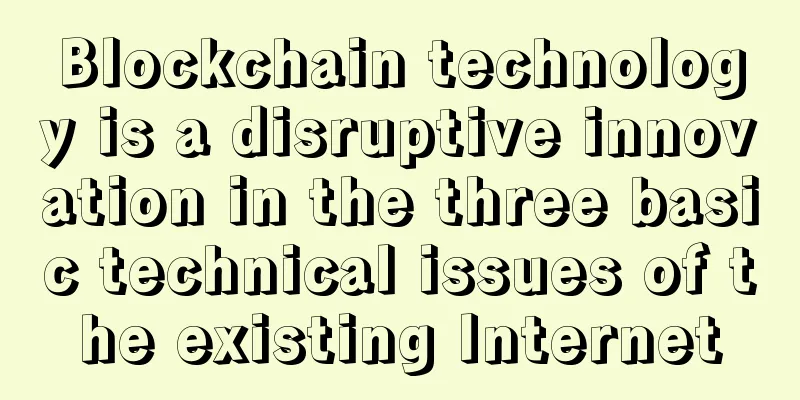Blockchain technology is a disruptive innovation in the three basic technical issues of the existing Internet

OverviewThere are three fundamental problems with the existing Internet infrastructure that have not been well solved:
Data can be easily tampered withIt is difficult to achieve immutability, and in the face of possible tampering, it is impossible to prove or disprove. For example, there are many files in a folder on a networked computer, which stores a huge amount of data. After a few hours of surfing the Internet, how do you know that the files in this folder have not been modified by hackers on the Internet? You should know that files mean everything to modern operating systems. Everything is a file, and files mean everything. If this basic problem cannot be verified or falsified, then any digital data of any individual, organization, company, or country cannot be prevented from being maliciously tampered with. Not only can it not be prevented from being tampered with, even if it is tampered with, you will not know it. What does this mean? Your bank deposits may disappear; your property may suddenly no longer belong to you one day; terrorists can use this loophole to attack banks and stock markets in hostile countries, etc. Why?At present, to ensure that data cannot be tampered with, a feasible method is to extract the data fingerprint of the data file, which may be a hash generated by any hash algorithm, such as sha1. Then the data fingerprint is stored in one place, stored together with the original file or separately. But the problem is, what if someone not only modifies the original file but also modifies the data fingerprint? It is still impossible to prove or disprove, so this problem has not been fundamentally solved. The idea of blockchain technologyBlockchain technology is equivalent to linking the fingerprint data of multiple data blocks. Each such data unit is called a block. Each block consists of a data fingerprint pointing to the previous block, the current time, and a proof of the workload consumed when generating the block. The reason for the existence of this proof of workload is to make the generation of each block consume a lot of computer computing power, and it is strongly random, which ensures that all data on the entire linked list cannot be tampered with or reversed. How to achieveThe use of blockchain technology can make data irreversible and unalterable, and it is independent of any individual, organization, company, or country. This data belongs to all participants, and all participants can jointly manage this data, and no one can modify this data. Denial of service attacks are a persistent problemInternet services and websites are difficult to resist Denial of Service (DoS) attacks, especially Distributed Denial of Service (DDoS) attacks. Why?To explain this problem, we must first understand what DoS and DDoS are. So what is DoS? Let's take a simple example: a bank ATM can only serve one person at a time. If others want to withdraw money, they can only queue up behind them. If the person who is withdrawing money wants to deliberately make things difficult for the people in the queue behind him for some reason, and only withdraws 100 yuan at a time, the people in the queue behind him who usually only need to queue for a few minutes may need to wait half an hour, an hour, or even longer to withdraw hundreds of thousands of yuan. This is a typical example of a denial of service attack. So what is a distributed denial of service attack (DDoS)? A bank branch may have several ATMs. If someone has a conflict with the branch and sends many people to occupy all the ATMs and withdraw and deposit money at the counter, it is very likely to paralyze the entire bank branch. Even worse is to launch a denial of service attack at multiple bank branches in the city at the same time. This is a distributed denial of service attack. No one will attack me.Some people may think: "I am harmless, no one will attack me." Don't be confused by the word "attack". In fact, many times during normal website operations, you will encounter many situations equivalent to DDoS. For example, a website may hold a promotion on a certain festival. The website's infrastructure can serve 10,000 visitors at the same time during peak hours. This is enough for a website with an average of only about 2k visits most of the time. However, if the promotion instantly attracts far more than 10,000 users, the effect is equivalent to DDoS, exactly the same. Therefore, anti-DDoS is not only to meet security needs, but also for normal operations. Possible solutionsTaking the example of bank branches above, the simplest and most direct method is to increase the number of service windows or ATMs. If the number of service windows can be increased infinitely, this would be a good solution, but this solution is too costly and has limited effect. Because the cost of DoS is very low, adding more service windows and ATMs can only alleviate the service crisis. Moreover, DoS attacks are likely to occur only in one day, so adding a large or small number of service windows is not cost-effective. Using blockchain to solve the problemThe blockchain itself is based on a P2P network, so the blockchain network itself does not have a central node, and all nodes can join or exit at any time. Each full node can provide services to users, so this solves the DDoS problem very well. reliabilityThe development of the BT network has proved that the P2P network is the most reliable network application in the world. Since BT went online, it has never terminated its service, which is unmatched by traditional centralized solutions. What about cloud computing? It is equivalent to a multi-center solution, but the case of Alibaba Cloud's fiber being cut and causing the entire cloud service to be interrupted proves that even with cloud services, it is impossible to achieve the high reliability of P2P networks. Any node in a P2P network can join and leave at any time, and there is no geographical restriction. Changes in business models
|
<<: Bitcoin prices fluctuated lower in Asian trading on Friday
Recommend
Facial features that will make you an athlete
Facial features that will make you an athlete Bei...
How to deduce the marriage age from the marriage line
The marriage age is sometimes estimated based on ...
Reserve Bank of India publicly supports blockchain technology
For those active in the bitcoin industry, a few t...
The cryptocurrency Vertcoin (VTC) has suffered four 51% double-spending attacks in the past two months
Data from PeckShield Situational Awareness Platfo...
A woman with Arhat eyebrows has a facial feature explanation. What are the characteristics of Arhat eyebrows?
Eyebrows are also one of the five facial features...
What is the function of the body palace?
What is the body palace? The body palace represen...
How is the fortune of people with flat noses? Is the life of people with flat noses good?
People with flat noses are not very ambitious If ...
Ethereum Sepolia testnet has completed merge testing
According to news on the evening of July 6th Beij...
What are the palm characteristics of people who are good at dancing with long sleeves?
In life, we have to deal with people, and some pe...
Is it good to have a mole on the index finger? Is there any special meaning?
There are more or less moles on people's bodie...
Your nose tells you whether you are loved by your husband
Your nose tells you whether you are loved by your...
What does Tianji in the Palace of Illness represent?
The star Tianji has the characteristics of being ...
Flat nose and big nose
Life experience tells us that we can tell whether...
How to know a man's fate by looking at his face? From which angle can we analyze a man's face?
1. Know a man’s fate by looking at his mouth If a...
Latest report: More than 100 million people use crypto assets worldwide, mining pools are active users of Asian cryptocurrency exchanges
The latest research report from the Cambridge Cen...









